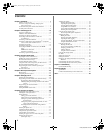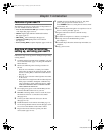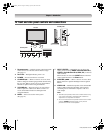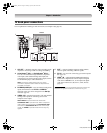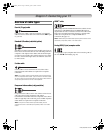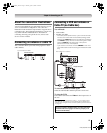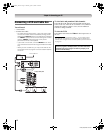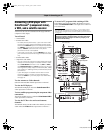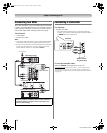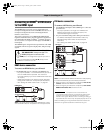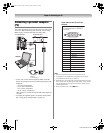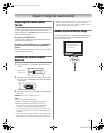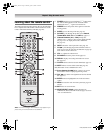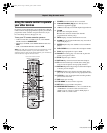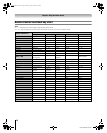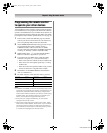
14
HL86 (E/F) Web 213:276
Chapter 2: Connecting your TV
Connecting two VCRs
This connection allows you to record (dub/edit) from one VCR
(“VCR1” in the illustration below) to a second VCR (“VCR2”)
while watching a videotape. You also can record from one TV
channel with VCR1 while watching another TV channel.
You will need:
• coaxial cables
• standard A/V cables
Note:
• If you have VCRs with S-video, use S-video cables instead
of standard video cables for better picture performance.
• Do not connect the same VCR to the output and input jacks
on the TV at the same time. To dub or edit, VCR 2 must
select LINE IN, and the TV must select Video 1.
Connecting a camcorder
You will need:
• standard A/V cables
– For better picture performance, if your camcorder has
S-video, connect an S-video cable (plus the audio cables)
to VIDEO-2 on the TV side panel.
To view the camcorder video:
Select the Video 2 video input source on the TV.*
*To select the video input source, press + on the remote control
(- page 30). To program the TV remote control to operate other
devices, see “Using the remote control to operate your other devices”
on page 19.
The unauthorized recording, use, distribution, or revision of
television programs, videotapes, DVDs, and other materials is
prohibited under the Copyright Law and may subject you to
civil and criminal liability.
IN from ANT
VIDEO AUDIO
OUT to TV
LR
R
L
OUT
IN
CH 3
CH 4
IN from ANT
VIDEO AUDIO
OUT to TV
LR
R
L
OUT
IN
CH 3
CH 4
Stereo VCR 1 (plays)
Stereo VCR 2 (records)
From antenna
TV lower back panel
TV upper back panel
VIDEO
AUDIO
OUT
L
R
VIDEO-2 inputs on
TV right side panel
Camcorder
263237HL86_EN.book Page 14 Monday, April 24, 2006 12:48 PM



